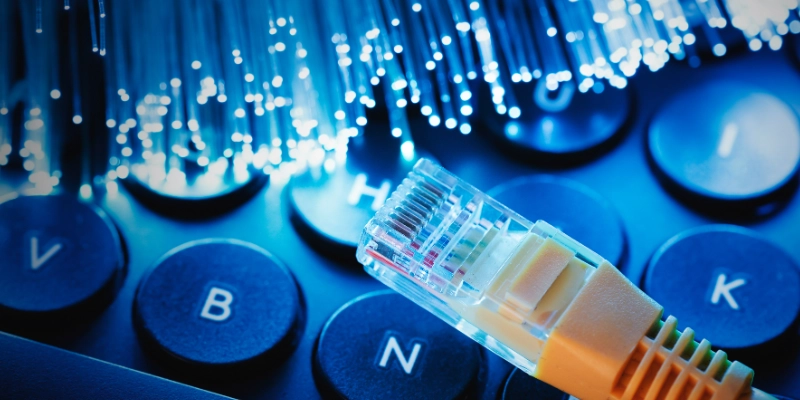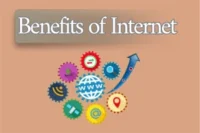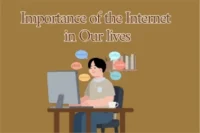What Is Broadband Internet? Complete Guide
Published: 31 Aug 2025
In today’s digital age, having a reliable internet connection is no longer a luxury it’s a necessity. From streaming high-definition movies to attending virtual classes, everything depends on fast and stable connectivity. This is where Broadband Internet (also called high-speed internet or broadband connection) comes in.
Broadband has replaced dial-up as the standard, offering users an always-on internet service that supports modern demands like video conferencing, gaming, telehealth, and remote work. But exactly what is broadband internet, how does it work, and why is it so important? Let’s break it down.
What Is Broadband Internet?
The term broadband refers to a high-bandwidth, high-capacity internet connection capable of transmitting large amounts of data simultaneously. Unlike dial-up, which requires a phone line and manual connection, broadband is always connected and provides much faster speeds.
Key Features of Broadband Internet:
- Always-on connection – no need to “dial” or reconnect.
- Higher speeds – far superior to older dial-up methods.
- Supports multiple devices – ideal for homes, businesses, and organizations.
- Multiple transmission technologies – including fiber, DSL, cable, satellite, and wireless.
The Federal Communications Commission (FCC) defines broadband as an internet service that provides minimum download speeds of 25 Mbps and upload speeds of 3 Mbps. However, with increasing demands, newer benchmarks often consider 100 Mbps download and 20 Mbps upload as the true standard of fast internet connection.
💡 In simple words: Broadband is the foundation of modern online life, powering everything from social media and gaming to education and healthcare.
Broadband vs. Dial-Up Internet
To truly understand the value of broadband internet service, it helps to compare it with dial-up:
| Feature | Dial-Up | Broadband Internet |
| Speed | 56 Kbps max | 25 Mbps – 1 Gbps+ |
| Connection | Manual | Always-on |
| Data Use | Single-task only | Multi-tasking supported |
| Reliability | Frequent disconnections | Stable & fast |
| Suitability | Email, text browsing | Streaming, gaming, remote work |
This comparison highlights why fast internet connections have become the global standard, leaving dial-up as a thing of the past.
Why Broadband Matters Today
Broadband internet isn’t just about speed, it’s about access and opportunity. Here’s why it plays such a vital role:
- Remote Work & Business – Cloud apps, Zoom calls, and real-time collaboration all require high-speed broadband access.
- Education – E-learning platforms depend on fast, stable connections.
- Entertainment – Streaming Netflix, YouTube, or gaming online is impossible without broadband.
- Healthcare – Telehealth relies on reliable video and data transmission.
- Social Connection – Video calls and social networking need robust internet connections.
Additionally, broadband helps reduce the digital divide by bringing reliable internet service to underserved communities, ensuring equal opportunities in education, work, and communication.

Types of Broadband Internet Connections
Different broadband technologies exist, and the right one depends on your location, budget, and usage. Here are the different types of Broadband Internet services available today:
- Fiber Optic Broadband
- Cable Broadband
- DSL (Digital Subscriber Line)
- Satellite Internet
- Fixed Wireless Broadband
1. Fiber Optic Broadband
Fiber optic broadband is considered the gold standard of high-speed internet connections. It delivers lightning-fast performance and is ideal for households or businesses with heavy internet usage.
- Fastest high-speed internet option.
- Uses light signals through glass fiber cables.
- Provides symmetrical speeds (equal upload & download).
- Examples: Verizon Fios, Google Fiber.
2. Cable Broadband
Cable broadband is one of the most widely used types of internet connections, especially in cities and suburbs. It offers fast download speeds but may slow down during peak hours.
- Uses existing TV cable infrastructure.
- Widely available in urban areas.
- High download speeds but often asymmetrical (uploads slower).
3. DSL (Digital Subscriber Line)
DSL broadband is a budget-friendly option that uses copper phone lines to deliver internet service. It’s faster than dial-up but not as advanced as fiber or cable.
- Uses traditional copper phone lines.
- Faster than dial-up but slower than fiber or cable.
- Speeds vary based on distance from the provider’s hub.
4. Satellite Internet
Satellite broadband is designed for rural and remote areas where other internet technologies may not reach. While it can be slower, it provides connectivity in places with no other options.
- Provides broadband access to remote and rural areas.
- Higher latency and often lower speeds.
- New services like Starlink are improving satellite-based fast internet connections.
5. Fixed Wireless & Mobile Broadband (4G/5G)
Fixed wireless and mobile broadband use cell towers and radio signals to deliver internet. With the rise of 5G networks, this option is becoming a strong alternative to wired connections.
- Uses radio signals or cellular towers.
- Growing in popularity with 5G networks.
- Great option in areas without fiber or cable.
Bandwidth vs. Speed: Clearing the Confusion
One common misunderstanding is between bandwidth and internet speed:
- Bandwidth: The maximum amount of data your connection can handle at once (measured in Mbps or Gbps).
- Speed: How fast data actually travels from source to destination.
Think of bandwidth as the width of a highway, while speed is the rate of cars traveling on it.
- Symmetrical broadband = Equal upload and download speeds (fiber).
- Asymmetrical broadband = Higher download, lower upload (DSL, cable).
Both factors are critical in determining how smooth your broadband internet connection feels in real-world usage.
How Broadband Internet Is Regulated
Government bodies like the FCC in the U.S. set standards for broadband definitions and speeds. Their guidelines:
- Ensure providers deliver what they advertise.
- Help consumers compare services.
- Support broadband expansion in underserved areas.
Programs like the Affordable Connectivity Program and Lifeline also help low-income households access reliable internet service at reduced costs.
Choosing the Right Broadband Connection
When selecting a broadband plan, consider these factors:
- Speed Requirements
- Basic browsing & email: 5–10 Mbps
- Streaming (HD/4K): 25–100 Mbps
- Gaming or home office: 100+ Mbps
- Number of Users/Devices
- More users require more bandwidth to avoid slowdowns.
- More users require more bandwidth to avoid slowdowns.
- Location
- Urban areas usually have access to fiber and cable.
- Rural areas may rely on satellite or wireless broadband access.
- Budget
- Fiber and cable may be more expensive, but they offer the best performance.
- DSL or fixed wireless can be cheaper alternatives.
Challenges Facing Broadband Internet
Even though broadband internet service is widespread, challenges remain:
- Digital Divide – Rural and low-income areas still lack equal access.
- Infrastructure Costs – Expanding fiber networks is expensive.
- Congestion – Shared broadband connections slow down during peak hours.
- Affordability – High-speed broadband is still costly for many households.
Emerging technologies like 5G broadband access and low-earth orbit satellites (e.g., Starlink) aim to solve these challenges and make fast internet connections universally available.
The Future of Broadband Internet
The future of high-speed broadband is exciting:
- Wider fiber rollout for faster, more stable connections.
- 5G mobile broadband offering wireless gigabit speeds.
- Satellite mega-constellations expanding global broadband coverage.
- Smart cities and IoT devices require always-on, reliable internet.
As demands grow, so will the standards, with 1 Gbps (or even 10 Gbps) becoming the new norm.
Conclusion
Broadband Internet also known as high-speed internet, broadband connection, or reliable internet service has transformed the way we live, work, and communicate. It replaced dial-up with always-on, fast internet connections capable of supporting everything from entertainment to education and healthcare.
By understanding what Broadband Internet is, its types, and how to choose the right plan, you can ensure a smooth digital experience for your home or business.
And as technology advances, the future promises even faster and more accessible broadband access, bridging the digital divide and powering the next wave of innovation.
If you found this article useful, let us know in the comments and share it with others who want to learn about broadband.
Frequently Asked Questions (FAQs)
Below you’ll find answers to common questions people have about Broadband Internet:
Broadband internet is a high-speed, always-on connection that allows you to access the web without having to dial in each time. It supports activities like streaming, video calls, gaming, and working online. Unlike dial-up, broadband is much faster and more reliable.
Broadband refers to the internet connection itself, which comes into your home through fiber, cable, or other technologies. Wi-Fi, on the other hand, is the wireless network that distributes that internet connection to devices like phones, laptops, and TVs. In short, broadband brings the internet in, Wi-Fi shares it around.
The common types of broadband internet are Fiber Optic, Cable, DSL, Satellite, Fixed Wireless, and Mobile Broadband (4G/5G). Each option has different speeds, costs, and coverage areas. The best type for you usually depends on where you live and how you use the internet.
Fiber optic broadband is the fastest and most reliable form of high-speed internet currently available. It uses light signals through glass cables, delivering speeds up to 1 Gbps or more. This makes it perfect for heavy internet use like 4K streaming, online gaming, and business operations.
The FCC defines broadband as at least 25 Mbps download and 3 Mbps upload. However, most providers now offer speeds of 100 Mbps or higher, which is considered standard for smooth streaming and multitasking. Faster packages are also available, especially with fiber connections.
Yes, broadband is essentially the technical name for high-speed internet that’s always on and much faster than dial-up. The term “high-speed” is used in everyday language, while “broadband” is more official and widely recognized in government and provider definitions.
Yes, but the options are often limited compared to urban areas. Satellite broadband and fixed wireless are the most common solutions for rural homes. New technologies like Starlink are also making fast internet connections more available in remote regions.
For HD streaming, you’ll need at least 25 Mbps, while 4K streaming or competitive gaming usually requires 50–100 Mbps. If multiple users are online at the same time, higher speeds are recommended. Choosing the right plan depends on your household’s internet usage.
Dial-up connects over phone lines and maxes out at just 56 Kbps, which is extremely slow by today’s standards. Broadband, by contrast, offers always-on, high-speed connections through fiber, cable, or wireless technologies. This makes broadband ideal for modern online activities.
Start by looking at how many devices and people will be using the internet. Consider what you’ll use it for light browsing, streaming, gaming, or remote work. Then compare available providers in your area based on speed, price, reliability, and customer reviews before making a choice.

- Be Respectful
- Stay Relevant
- Stay Positive
- True Feedback
- Encourage Discussion
- Avoid Spamming
- No Fake News
- Don't Copy-Paste
- No Personal Attacks

- Be Respectful
- Stay Relevant
- Stay Positive
- True Feedback
- Encourage Discussion
- Avoid Spamming
- No Fake News
- Don't Copy-Paste
- No Personal Attacks





